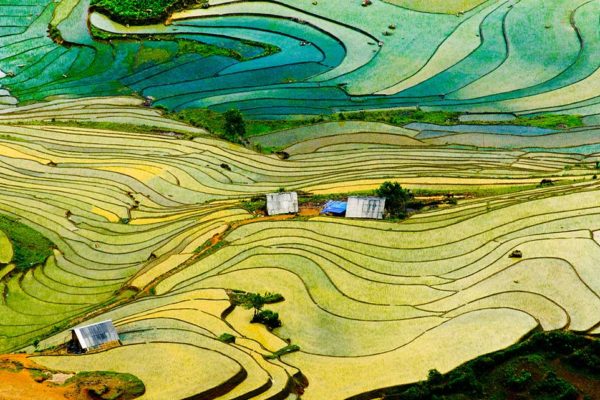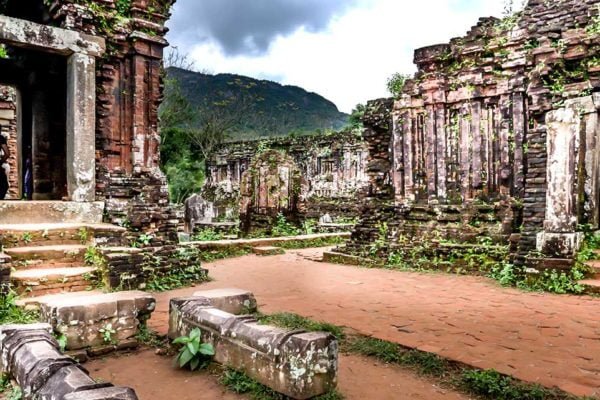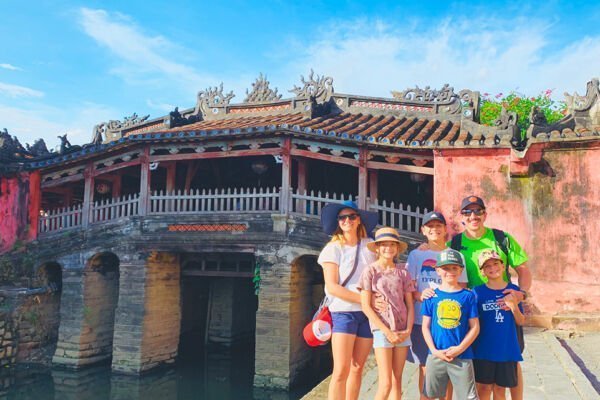Heavenly Peaks: The Most Beautiful Mountains in Vietnam for Nature Lovers
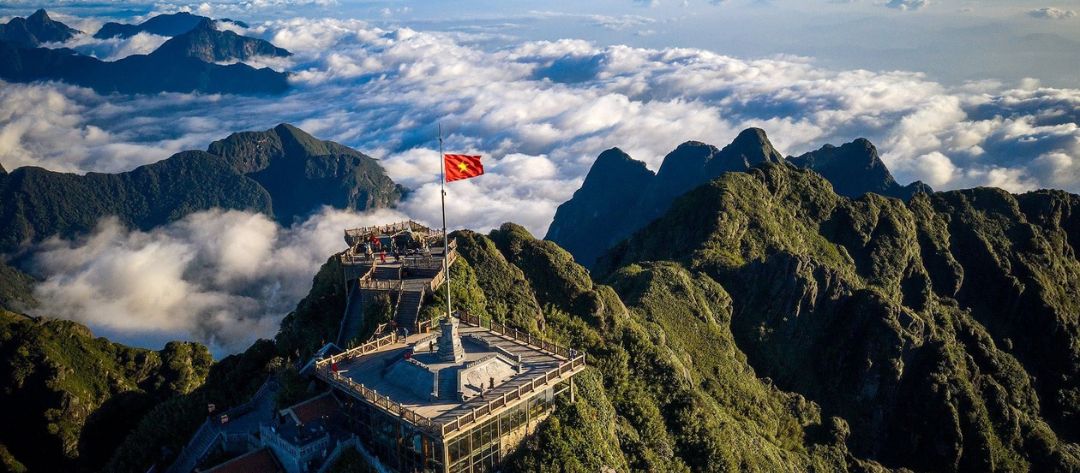
Vietnam’s mountains cover over 75% of the country’s land, shaping its landscapes, cultures, and adventures. Each peak offers something different: jungle-cloaked trails, ancient pagodas, terraced rice fields, or sunrise scenes that stay with you forever. Hikers, photographers, and cultural explorers alike will find plenty to love in these highlands. Some peaks test your endurance, others invite quiet moments with nature or insight into local ethnic life. This list highlights 17 must-visit mountains in Vietnam, places where the journey is just as rewarding as the view.
Why Vietnam’s Mountains Call to Nature Lovers
Biodiversity highlights
Vietnam’s mountains captivate explorers with their lush biodiversity and pristine natural beauty. Dense evergreen forests, bamboo groves, and ancient oak trees form a striking backdrop for trekking routes. The Hoang Lien Son range in the north is notable for its endemic species and vibrant azalea blooms in the spring.
National parks, such as Bach Ma near Hue and Chu Mom Ray in the Central Highlands, are home to rare wildlife, including the pygmy loris and the red-shanked douc langur. UNESCO-recognized sites like Phong Nha-Ke Bang, with its limestone mountains and Son Doong—the world’s largest cave—make the landscape even more extraordinary.
Culture
Vietnam’s highlands are home to over 50 ethnic groups, each preserving its traditions and vibrant attire. Villages in Sapa are inhabited by Hmong and Red Dao communities, while Mai Chau welcomes visitors with the warmth of the White Thai and Black Thai.
Cultural experiences include homestays in stilt houses, visits to colorful local markets, and traditional craft workshops. The iconic terraced rice fields in Mu Cang Chai and Lao Cai, cultivated for centuries, shift from emerald green to golden yellow during harvest, creating a living cultural landscape.
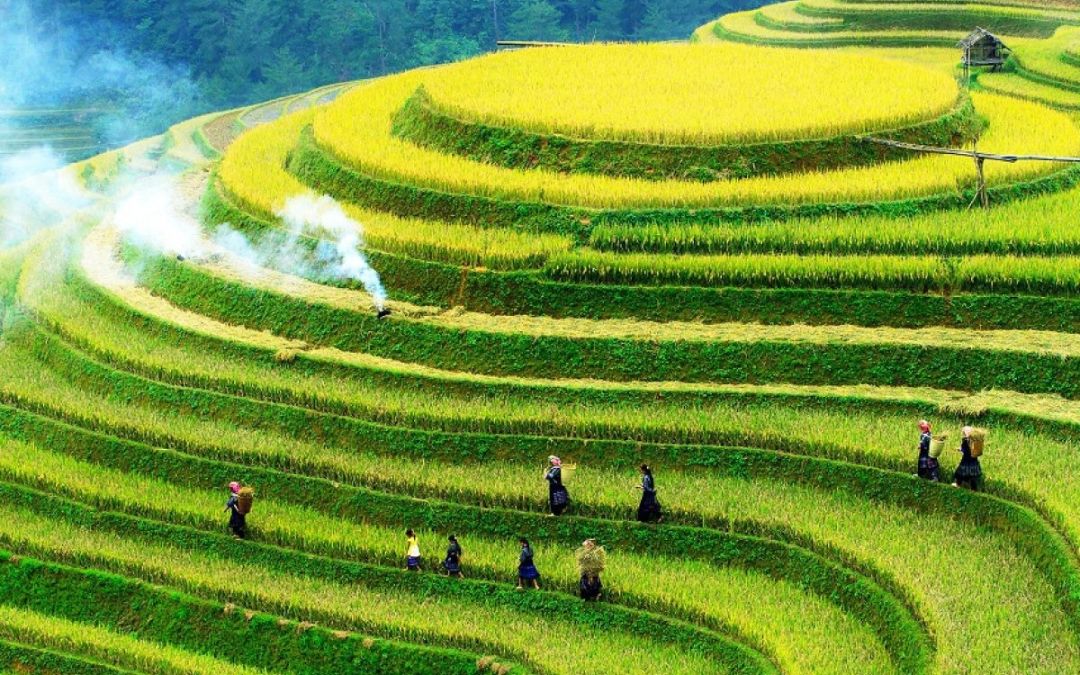
Green rice terraces and daily life of farmers in Mu Cang Chai & Lao Cai.
Regions Overview: North, Central, and South
Northern Vietnam features dramatic peaks, limestone karsts, and challenging treks. Fansipan, at 3,147 meters, is the highest point in Indochina, followed by Putaleng, Ky Quan San, and Pusilung. Scenic provinces like Ha Giang, Cao Bang, and Yen Bai are celebrated for rice terraces and rugged beauty.
Central Vietnam blends mountain and coast, with Bach Ma Mountain, Hai Van Pass, and the Marble Mountains offering sweeping views. The Central Highlands, including Da Lat and Lang Biang, boast pine forests and cool weather. In the south, peaks such as Ba Den (996 meters) and Chua Chan highlight spiritual sites and panoramic vistas.
Top Mountains in Vietnam & What Makes Them Stunning
Fansipan – “Roof of Indochina” (Lào Cai)
- Best for: Serious trekkers, bucket-list climbers, and nature photographers.
Rising to 3,143 meters, Fansipan is the highest peak in Vietnam and has long been hailed as the “Roof of Indochina.” From its summit, travelers can witness sweeping views of the Northwest’s dramatic mountain ranges, deep valleys, and winding rivers, especially magical at sunrise or when clouds roll beneath the peaks.
Trekking to Fansipan is a true test of endurance, covering nearly 20 kilometers with steep ascents and rocky terrain. The Tram Ton route is favored for its manageable distance and varied landscapes. Treks typically span 2 to 3 days, with porters and local guides essential.
For a quicker journey, a scenic cable car glides above forested slopes and mountain ridges. Climbers must secure a permit through Hoang Lien Son National Park. The best seasons are March and November, or between September and April when trails are dry and temperatures are moderate.
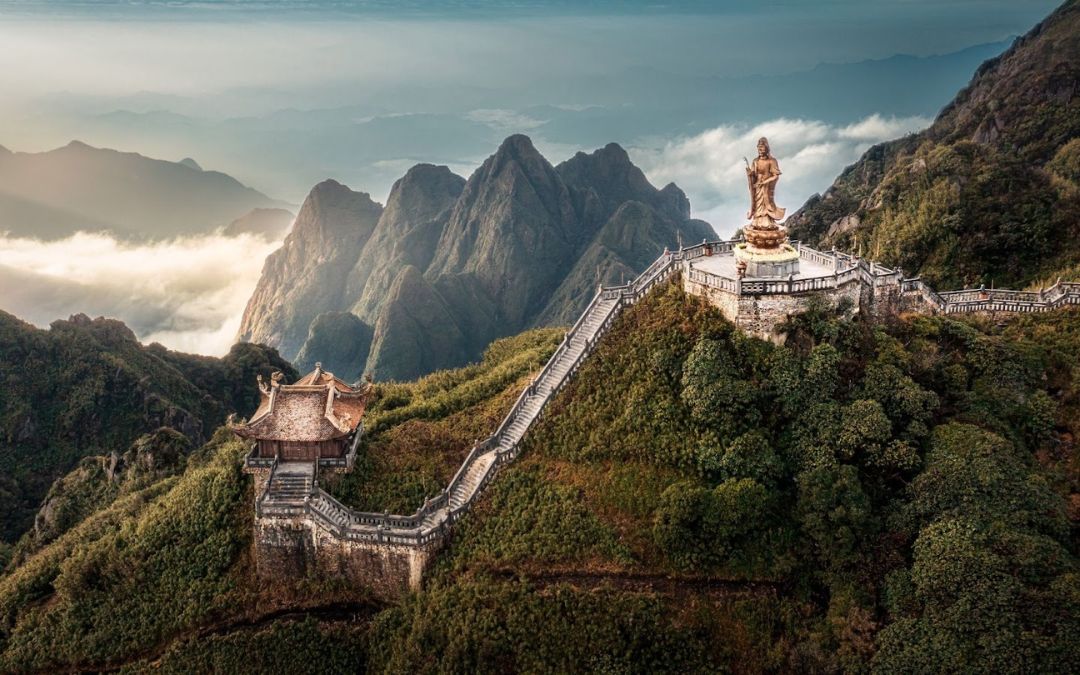
Fansipan’s summit rewards adventurers with clouds, views, and sacred serenity.
>> See Tour: Hanoi – Sapa – Ninh Binh – Halong Bay Tour
Hoang Lien Son Range & Sapa Surroundings
- Best for: Cultural hikes, Hmong village experiences, guided nature walks.
Stretching across northern Vietnam, the Hoàng Liên Sơn range surrounds the highland town of Sa Pa, forming a majestic landscape of misty peaks, cascading waterfalls, and tiered rice fields. At 1,500 meters above sea level, Sa Pa enjoys a cool climate year-round, making it a refreshing retreat from the lowland heat.
Beyond its scenic beauty, the region is rich in cultural heritage. Trekking routes wind through remote valleys where ethnic minority groups such as the Hmong and Red Dao continue age-old traditions.
Visitors can hike between villages, visit bustling local markets, and stay in traditional stilt houses for an immersive experience. The best months to see the green rice terraces are from May to June, while the golden harvest season falls in September and October.
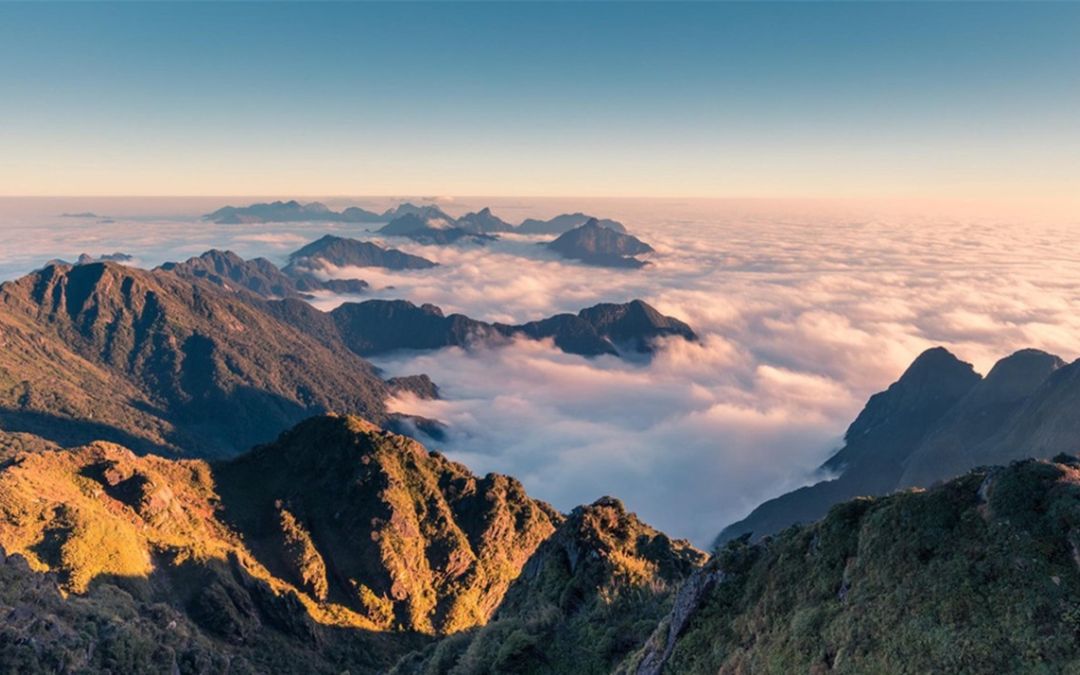
Paint golden curves, Sa Pa’s terraced fields ripple gently through the valleys.
>> Read More: Best Sapa Trekking Routes That Will Show You The Charm of This Land
Ma Pi Leng Pass (Ha Giang)
- Best for: Epic motorbike rides, road-trippers, adventure travelers.
Among the most striking sights in the mountains in Vietnam, Ma Pi Leng Pass cuts along the edge of towering limestone cliffs in Hà Giang province. This serpentine road hangs high above the jade-colored Nho Que River, winding through deep gorges and vertical rock faces. It’s widely considered one of the most awe-inspiring mountain passes in Southeast Asia.
The region is also home to diverse ethnic communities with vibrant markets, traditional costumes, and stilt houses dotting the hillsides. Travelers can combine the scenic drive with cultural stops in Meo Vac, Dong Van, and local villages. The Ha Giang Loop is a popular 3- to 5-day motorbike route that showcases the wild beauty of Vietnam’s northernmost frontier.
Motorbike rentals cost around 200,000–300,000 VND per day, while guided Ha Giang Loop tours range from 3,000,000 to 5,000,000 VND for multi-day trips with accommodation. Don’t miss panoramic stops along Ma Pi Leng Skywalk and boat rides on Nho Que River.
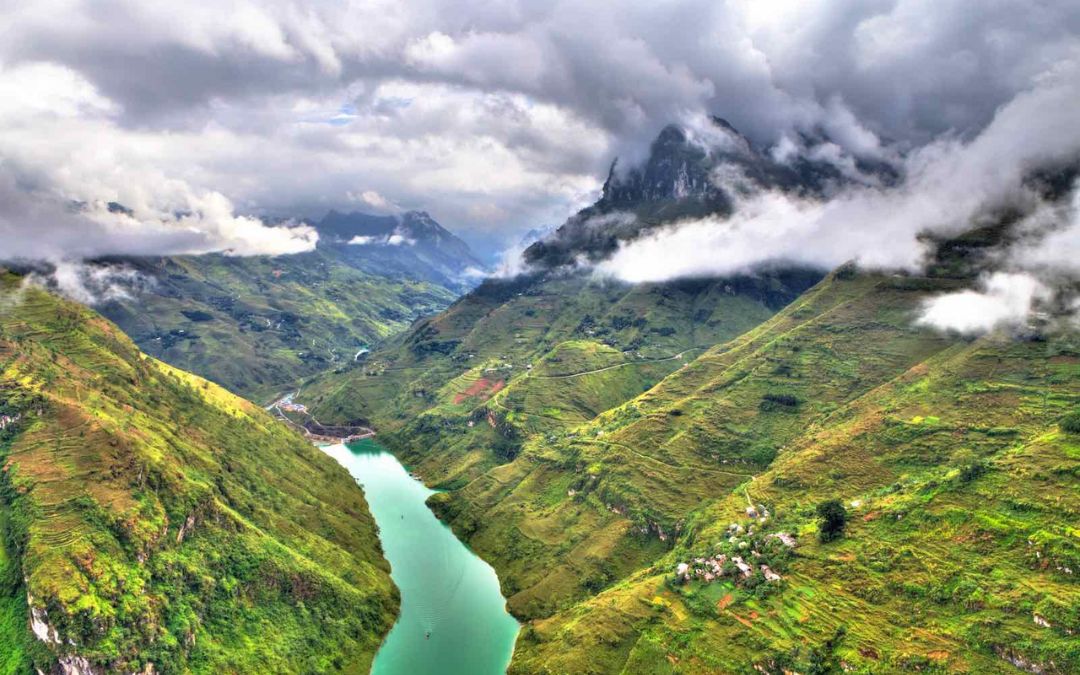
Ma Pi Leng Pass snakes above the jade river, carving through the cliffs.
>> See Tour: Discover Ha Giang & The Far North
Lung Cung & Tram Tau (Yen Bai)
- Best for: Off-the-beaten-path hikers, photographers.
Lung Cung Peak, standing at 2,913 meters, is a lesser-known gem for trekkers seeking solitude and raw nature. Located in Yen Bai province, this area is filled with the sounds of rushing streams, birdsong, and rustling forest canopies.
November to December brings a vibrant display of wildflowers, red maple leaves, and misty mornings, creating an almost dreamlike atmosphere. Nearby Mu Cang Chai is famed for its terraced rice fields cascading across 2,200 hectares of mountainside—most brilliant in September and October during harvest season.
These terraces, sculpted by the H’mong people over generations, form golden steps that stretch endlessly into the horizon. Highlights include the sweeping rice terraces of La Pan Tan and the tranquil sunrise at Lung Cung’s summit, where clouds drift slowly between mountain folds.
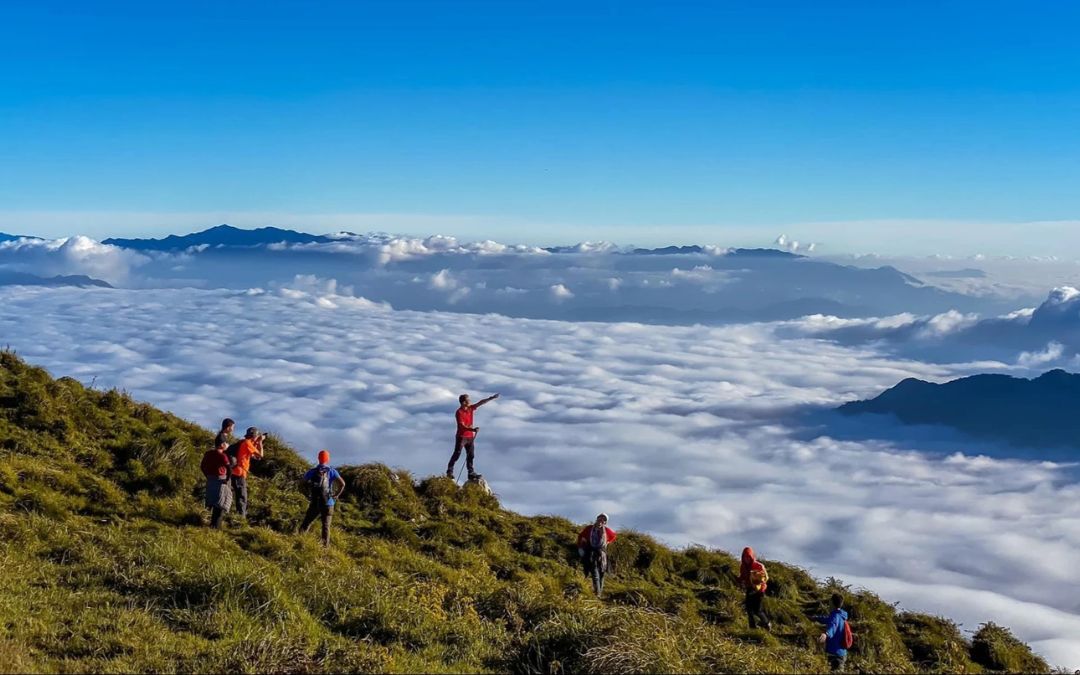
Those who seek calm beyond the beaten path find peace in Tram Tau.
Ta Xua Dinosaur Backbone (Son La)
- Best for: Cloud-seekers, Instagrammers, sunrise chasers.
Ta Xua in Sơn La is a legendary destination for “cloud hunters” seeking surreal landscapes above the mist. From September to March, thick clouds float between mountain ridges at dawn, creating a dreamlike sea of white.
The most iconic spot here is the “Dinosaur Spine,” a narrow ridgeline trail where trekkers appear to walk on the back of a dragon, surrounded by layers of drifting fog and golden morning light.
Besides cloudscapes, Ta Xua charms visitors with ancient forests, moss-covered trees, and stargazing nights free from city lights. This area remains largely undeveloped, attracting those who crave stillness and raw beauty. The trail is moderately difficult, with narrow paths and windy ridges requiring steady footing and a bit of courage.
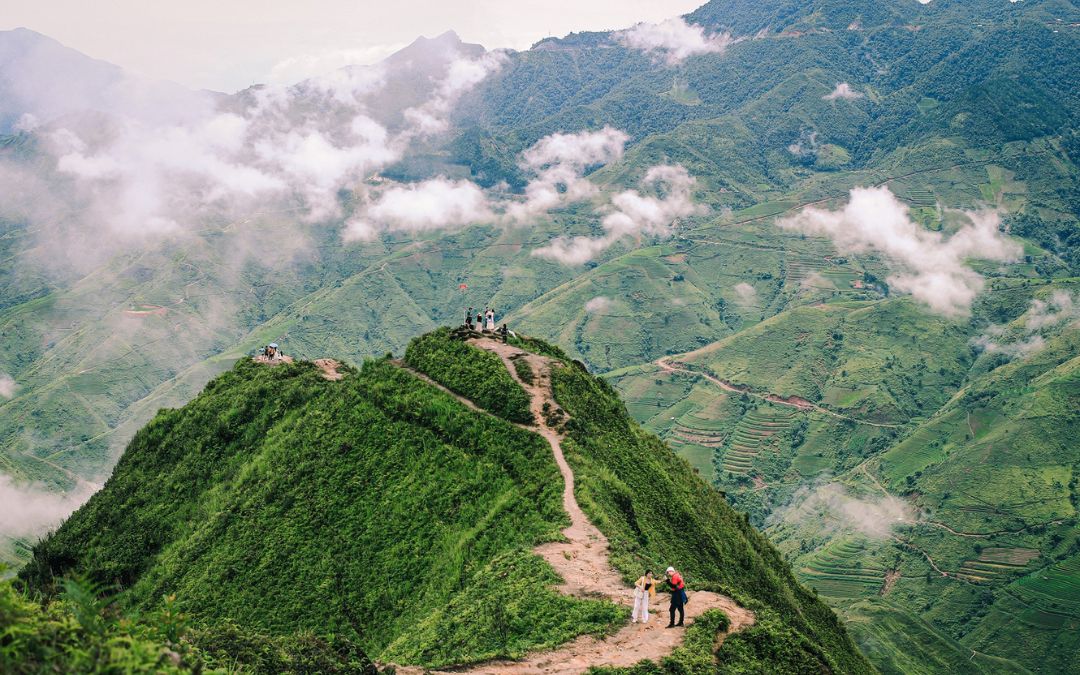
Clouds above the silent peaks greet trekkers on the Ta Xua spine.
Pu Ta Leng (Lai Chau)
- Best for: Hardcore climbers, untouched jungle exploration.
Not far from the famous Fansipan, Pu Ta Leng quietly claims its place as the second-highest mountain in Vietnam, reaching 3,049 meters. This remote peak in Lai Chau is wrapped in ancient forests and swirling clouds, rewarding only the most determined with pristine views and floral corridors of blooming azaleas in April and May.
The trek spans 3 to 5 days, navigating rugged trails, mossy cliffs, and near-vertical ascents that demand full physical effort. It’s a serious climb for adventurers seeking wild terrain and solitude. Guided tour prices range between 2,500,000 and 4,000,000 VND, often including meals, porters, and camping gear.
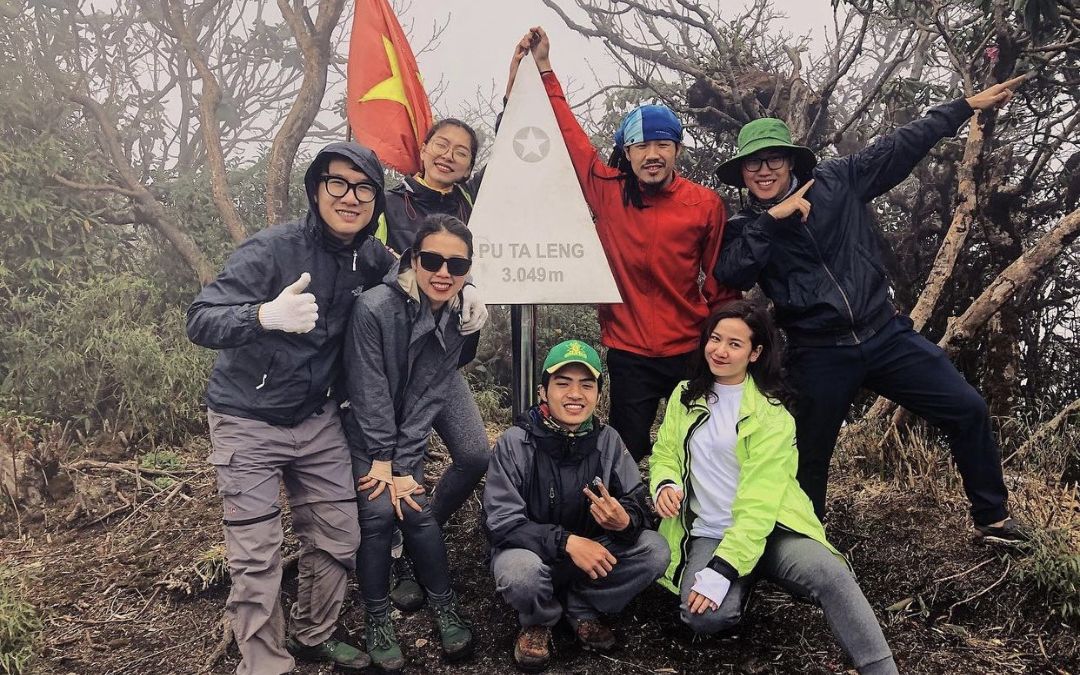
Pu Ta Leng guards its untamed heights, testing trekkers through jungles.
Bach Ma National Park (Thua Thien Hue)
- Best for: Day hikers, biodiversity lovers, and birdwatchers.
Once a retreat for French colonialists, Bạch Mã National Park today draws visitors with its cool mist, ancient trees, and quiet forest paths. The mountain rises gently to 1,450 meters, making it a pleasant choice for those wanting a nature fix without an intense climb.
Visitors can explore the park’s Five Lakes trail or admire the Do Quyen Waterfall crashing through the jungle. The panoramic Sea Watch Tower is perfect at sunrise. Entrance fees are budget-friendly, around 60,000 VND, and guided walks range from 300,000 to 600,000 VND, depending on the trail. Transport from Hue is quick, about 1.5 hours by car or motorbike.
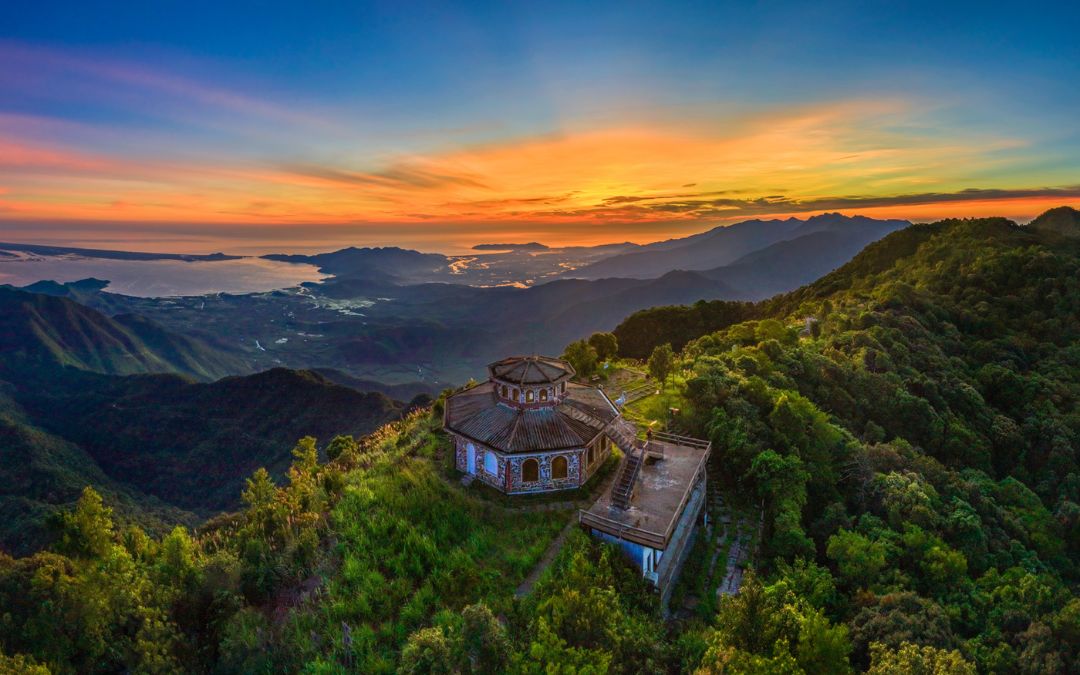
Views, history, and cool forest air await hikers in Bạch Mã National Park.
>> Read More: Top 13 Vietnam National Parks to Visit for Nature Lovers
Langbiang Mountain (Da Lat)
- Best for: Light trekking, couples, jeep safaris.
Often seen as the “roof” of Da Lat, Lang Biang stands at 2,167 meters and blends light adventure with sweeping views of the highlands. The peak is tied to K’ho ethnic legends, giving the mountain cultural resonance beyond its natural beauty.
Whether you trek or hop on a jeep, reaching the summit unveils a landscape of pine valleys and scattered lakes below. Visitors often combine this with stops at flower gardens or coffee plantations. The full experience, including jeep rides and entry, usually costs 100,000–150,000 VND, with add-ons for local cultural tours.
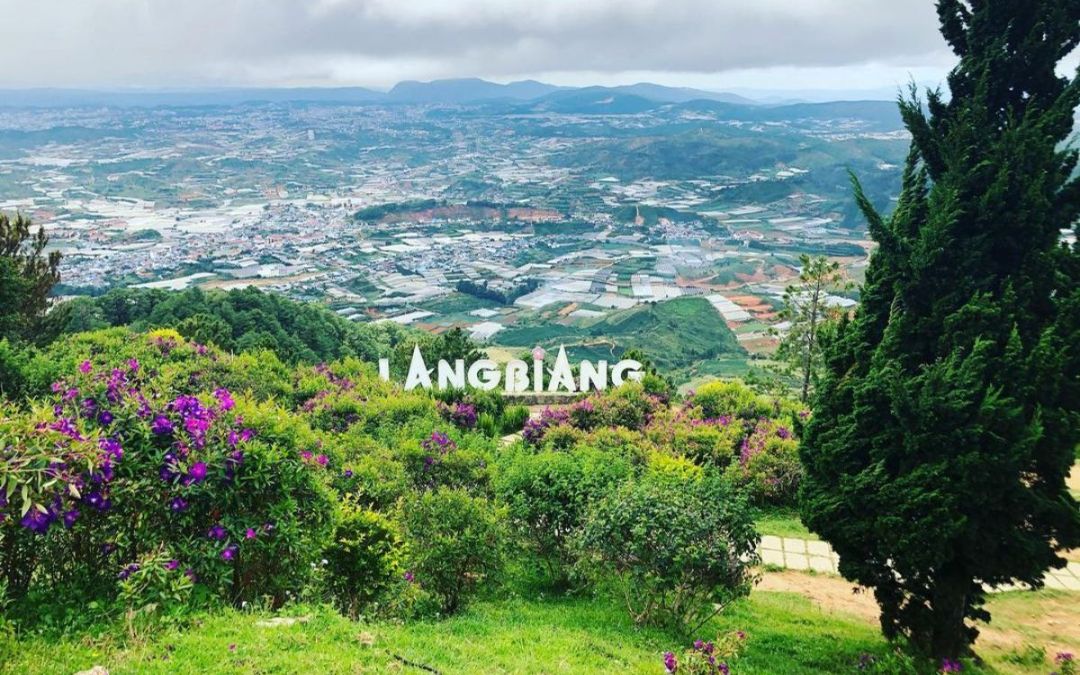
Sweeping pine valleys and lakes unfold below Langbiang’s legendary peak.
>> Read More: Top 17 Beautiful Places To Visit In Da Lat For A Dreamy Mountain Escape
Marble Mountains (Da Nang)
- Best for: Spiritual seekers, cave explorers, casual walkers.
Unlike towering peaks of the far north, the Marble Mountains near Da Nang present a different kind of elevation—one steeped in myth and meditation. These five marble and limestone hills symbolize the five elements and are dotted with ancient pagodas, shrines, and hidden caves carved into the rock.
Climbing Thuy Son, the largest of the group, reveals winding stone staircases, incense-filled temples, and sweeping views of the coastline. Among its sacred spaces, Huyen Khong Cave stands out for its vast, cathedral-like chamber where sunlight streams through holes in the ceiling and chants echo gently off the walls. It’s a place of deep stillness—a meditative silence that lingers long after you leave.
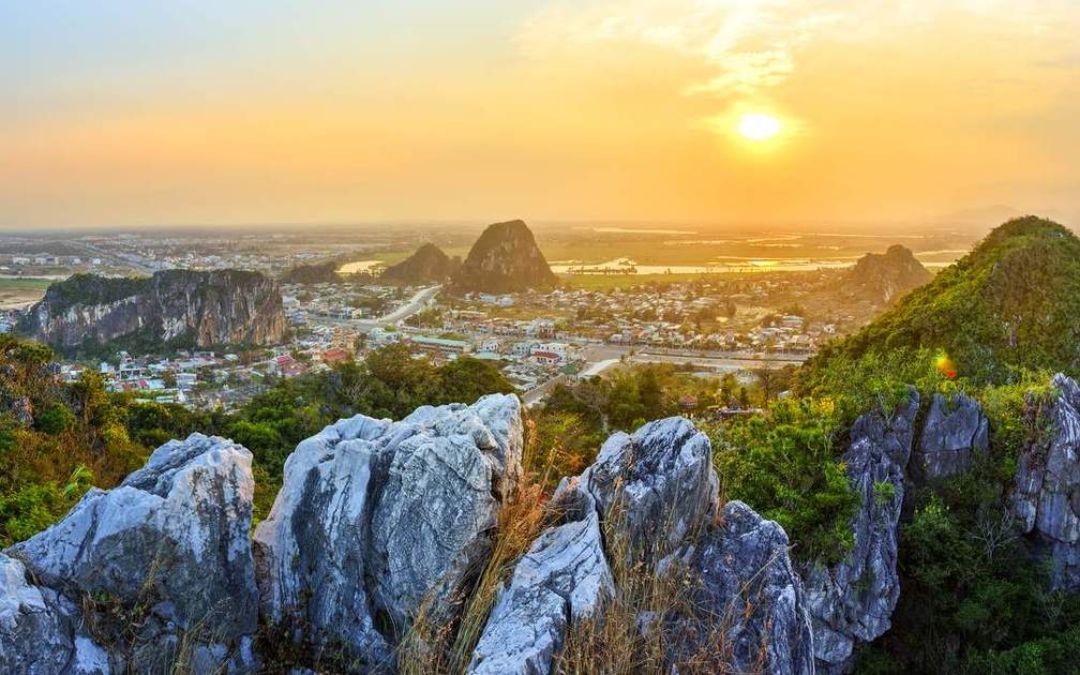
Huyen Khong Cave offers spiritual seekers light, silence, and serenity.
Son Tra – Monkey Mountain, (Da Nang)
- Best for: Nature drives, eco-watching, coastal hikes.
When it comes to mountains in Vietnam that blend biodiversity with coastal beauty, Son Trà Peninsula stands in a class of its own. Towering above Đà Nẵng, this forested peak stretches into the sea, forming a natural shield for the city. Roads twist through jungle-covered hills, revealing sudden views of turquoise bays and ancient pagodas.
The peninsula is a haven for nature lovers. Rare wildlife such as the red-shanked douc langur can often be spotted resting in treetops or leaping between branches. Winding trails lead to hidden beaches, the revered Linh Ung Pagoda, and mossy stone paths deep in the forest. Catching a glimpse of langurs at dawn and watching the sun dip behind Ban Co Peak are two unmissable experiences, revealing the quiet magic that defines Son Tra.
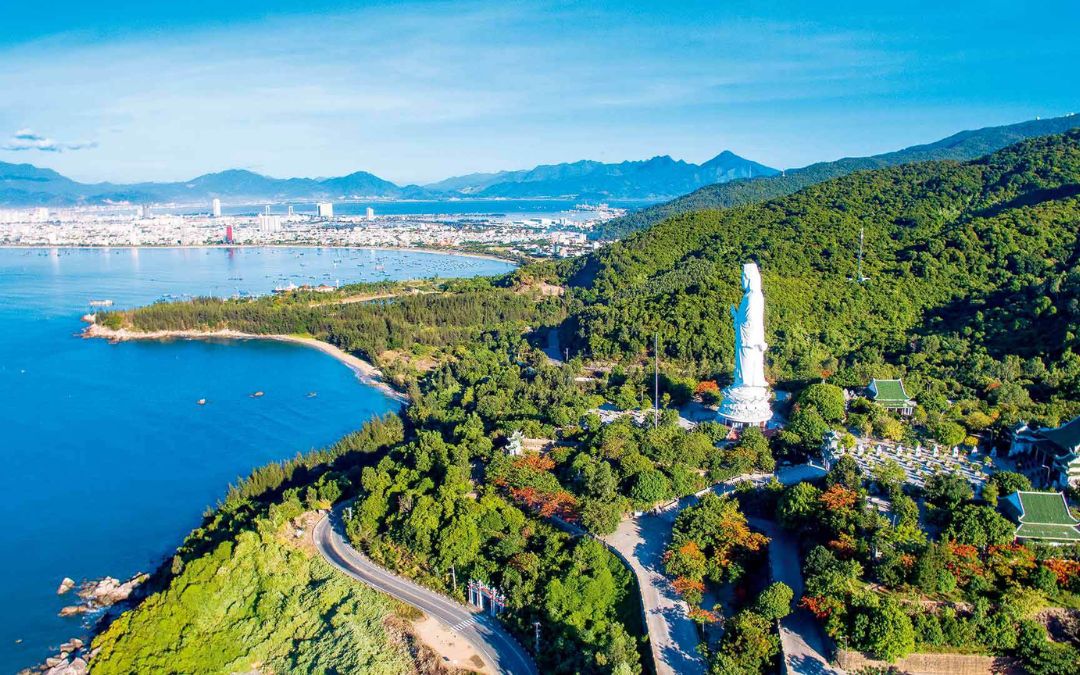
Sacred views and rare forest wildlife await nature lovers on Son Tra.
>> Read More: A Da Nang Tour Guide to Unveil This City’s Charm
Ngoc Linh (Kon Tum/Quang Nam)
- Best for: Scientific trekkers, ecotourists.
Soaring to 2,598 meters, Ngoc Linh is the highest peak in Vietnam’s Central Highlands, straddling the provinces of Kon Tum and Quang Nam. The mountain is famed not only for its formidable terrain but also for its ecological and medicinal significance. Trekking here means venturing through dense bamboo forests, crossing wild rivers, and climbing steep ridgelines where few tourists tread.
Ngoc Linh is also the only known home of Ngoc Linh ginseng (Panax vietnamensis)—a rare and highly valued medicinal plant endemic to this region. The biodiversity is astonishing, with over 1,500 plant species and 300 animal species recorded. This mountain is both a scientific treasure and a spiritual destination for those who seek a deeper connection with nature.
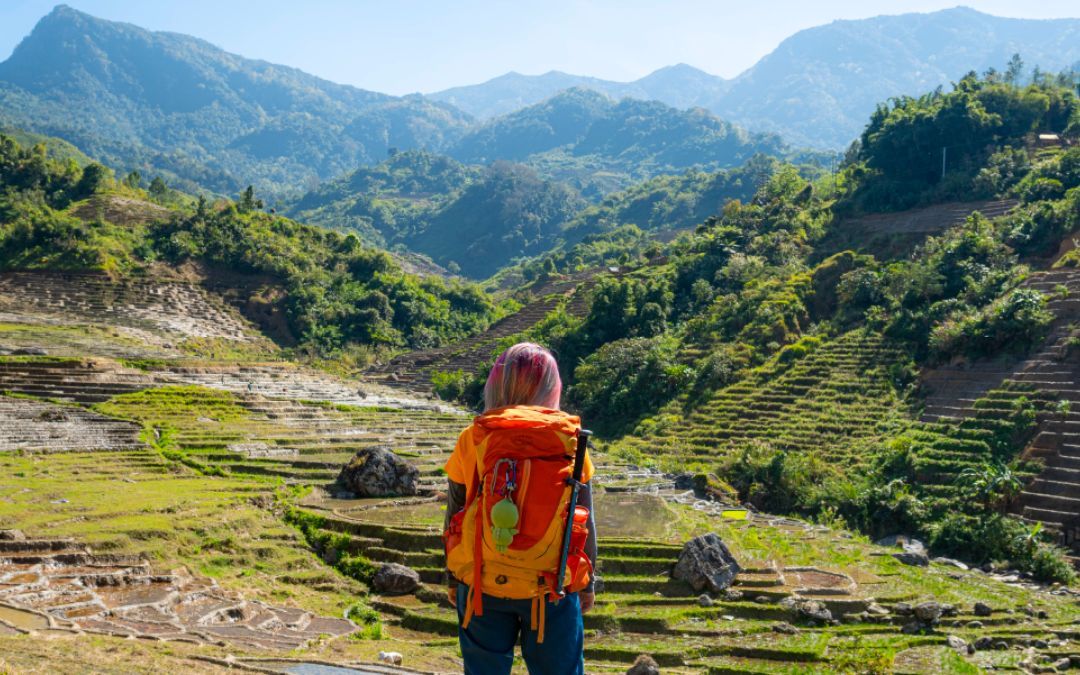
Ngọc Linh reveals rare ginseng and deep nature to scientific trekkers.
Ta Cu Mountain (Binh Thuan)
- Best for: Light hiking, temple visits, panoramic cable car rides.
Located in Binh Thuan Province, about 30 km from Phan Thiet city, Ta Cu Mountain rises to 649 meters and is famed for housing Vietnam’s largest reclining Buddha statue, stretching 49 meters long and 11 meters high. Nestled in a quiet forest clearing near the summit, the statue draws both pilgrims and travelers intrigued by its peaceful setting.
Ta Cu offers multiple ways to ascend—either by trekking up more than 1,000 stone steps or taking a scenic 15- to 20-minute cable car ride. The journey leads through subtropical forest, passing ancient pagodas, scattered Buddha statues, and viewpoints that reveal the undulating countryside and distant coastline. The climate is cool year-round, making it a popular weekend retreat for those escaping the southern heat.
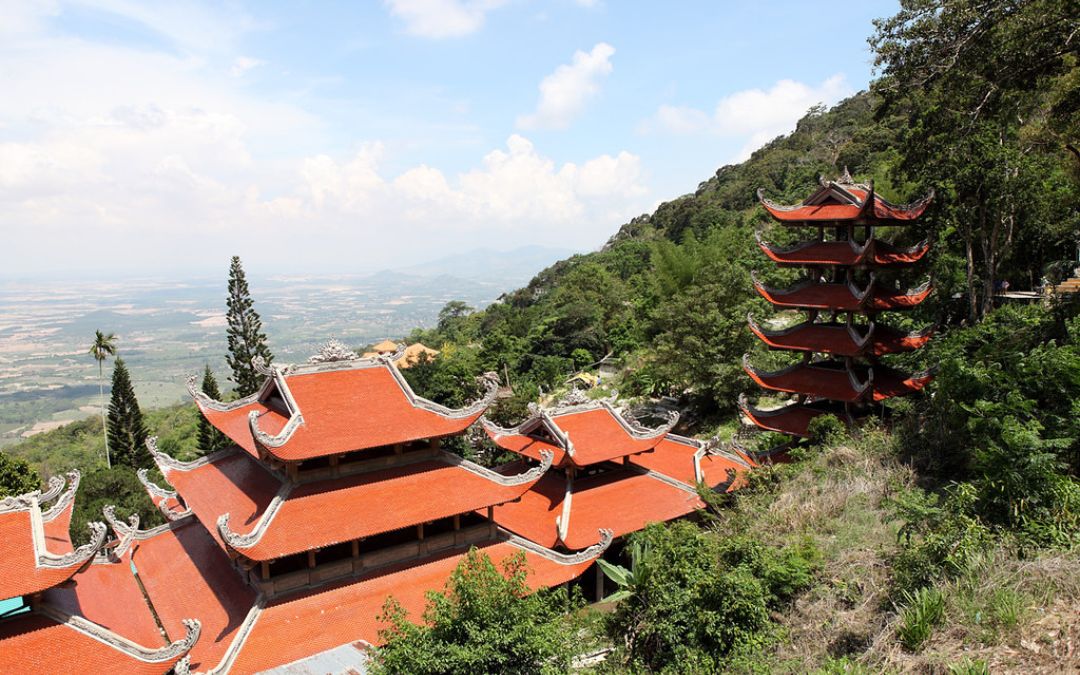
Visitors find peace in Ta Cu’s pagodas, forest trails, and cool mountain air.
Chu Yang Sin (Dak Lak)
- Best for: Jungle trekking, wildlife enthusiasts, spiritual solitude.
Rugged and remote, Chu Yang Sin Mountain lies deep within Dak Lak Province and stands as the tallest peak in the Chu Yang Sin National Park at 2,442 meters. Though less visited than other famous peaks, it is a biodiversity hotspot and one of Vietnam’s last truly wild mountain areas.
The mountain is covered by dense rainforest and cloud forest, sheltering endangered species such as the grey-shanked douc langur and Annamite striped rabbit. Few marked trails exist, making the ascent challenging and requiring local knowledge. Trekkers often cross streams, navigate thick undergrowth, and camp in forest clearings under a starlit sky. The summit provides sweeping views of the Central Highlands, often veiled in mist.
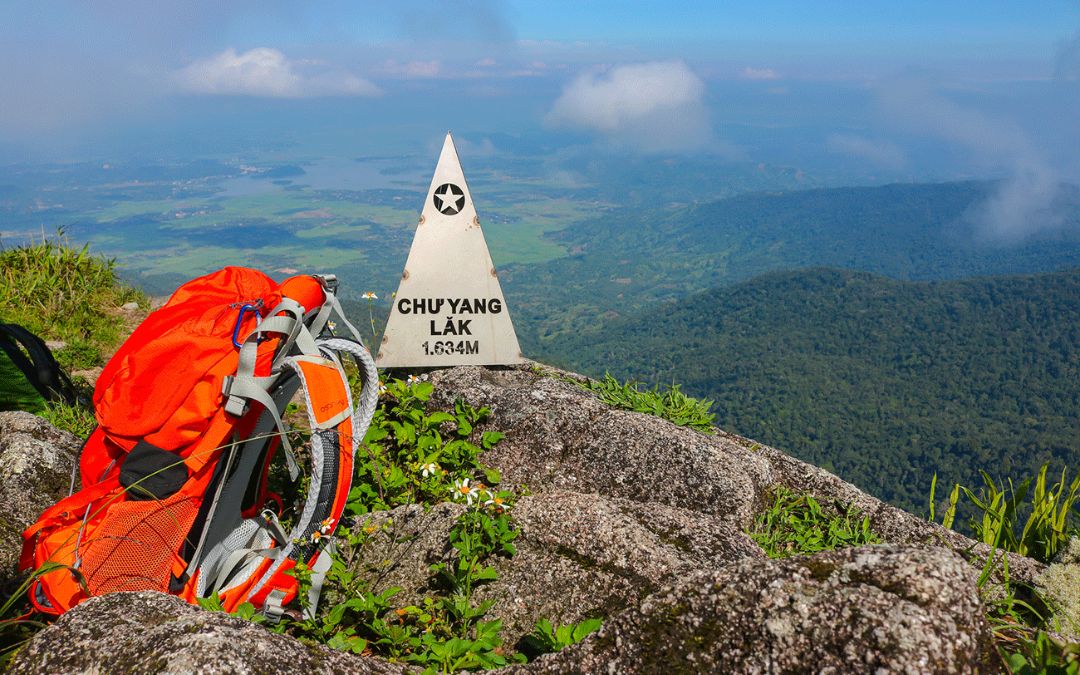
Mist, solitude, and raw nature await jungle trekkers on Chư Yang Sin.
Ba Vi Mountain (Ha Noi outskirts)
- Best for: Day trips, short hikes, local family outings.
Just 60 km west of the capital, Ba Vi Mountain Range rises quietly behind the urban sprawl, forming the heart of Ba Vi National Park. The range includes three main peaks: King Peak (1,296 m), Tan Vien Peak (1,281 m), and Ngoc Hoa Peak (1,131 m). The area is known for its rich tropical biodiversity, mysterious jungle atmosphere, and cool, mist-covered climate that persists even in summer.
Ba Vi is ideal for short hikes and spiritual retreats. The trail to the summit of King Peak takes you past moss-covered forest, cloud-wrapped trees, and finally to the Ho Chi Minh Temple, perched dramatically near the top.
Streams, waterfalls, and colonial-era ruins deepen the sense of both natural and historical richness. With over 1,200 plant species and 60 mammal species, the park also serves as a living museum of Vietnam’s lowland mountain ecosystems.
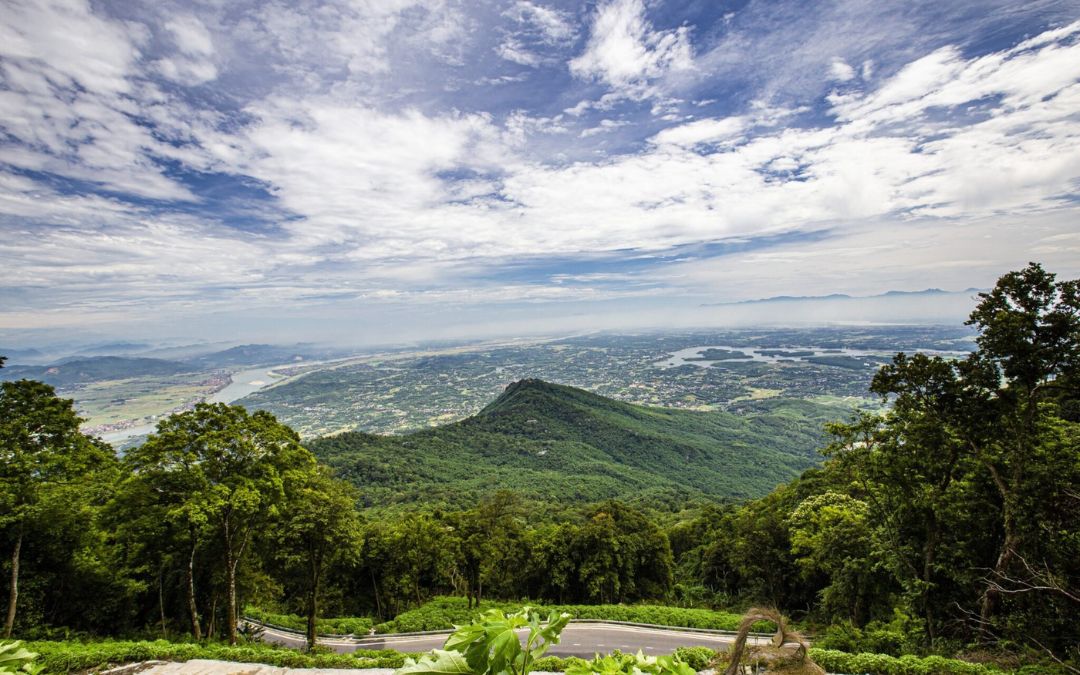
Ba Vi Mountain blends tropical forest charm with quiet cultural relics.
Tay Con Linh (Ha Giang)
- Best for: Experienced climbers, local-immersion travel.
Located in Ha Giang Province, Tay Con Linh is the highest peak in northeastern Vietnam, reaching 2,419 meters above sea level. Often shrouded in clouds, it remains one of the least-traveled major mountains in the country. The trek to the summit is long and strenuous, cutting through untouched forests, steep ridges, and vast stretches of mossy rocks.
What sets Tay Con Linh apart is its isolation—villages are few, and trails are wild. The journey offers glimpses into the lives of ethnic minorities such as the Dao and H’mong, whose homes are scattered at the mountain’s base. From the summit, climbers can see deep into valleys, layers of limestone peaks, and sometimes even the outlines of southern China on clear days.
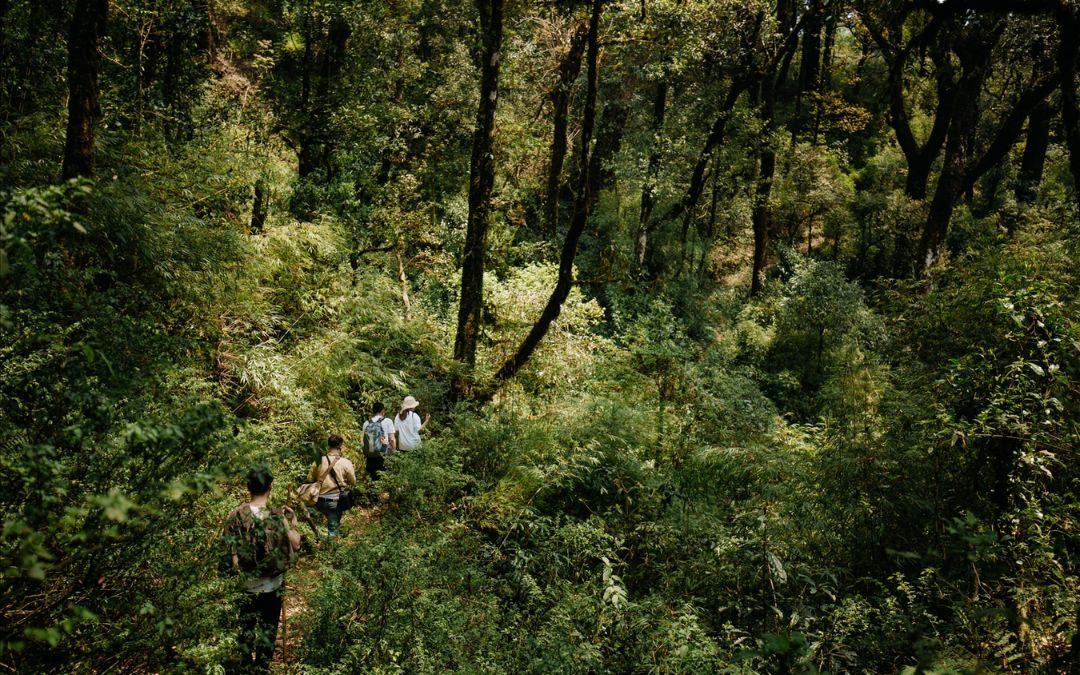
Villages and clouds in silent highlands rest beneath Tay Con Linh’s peak.
- >> See Tour: Ha Giang Tour: Meet The Local
Cam Mountain (An Giang, Mekong Delta)
- Best for: Pilgrimage hikers, delta-region nature lovers.
Rising to 710 meters, Cam Mountain is not just the highest point in An Giang’s That Sơn range but also a deeply revered spiritual destination. Known locally as the “Forbidden Mountain”, it is steeped in folklore, with tales of monks meditating in caves, wild tigers once roaming the slopes, and divine encounters believed to take place in its misty heights.
The journey upward is a choice between a serene cable car ride or a more immersive hike along ancient stone steps winding through dense forest. At the summit, pilgrims are greeted by monumental sites like the 49-meter-tall Big Buddha statue and the peaceful Van Linh Pagoda, both perched among cliffs and clouds. Early mornings unveil sweeping views of rice fields, rivers, and scattered villages below, all veiled in morning mist.
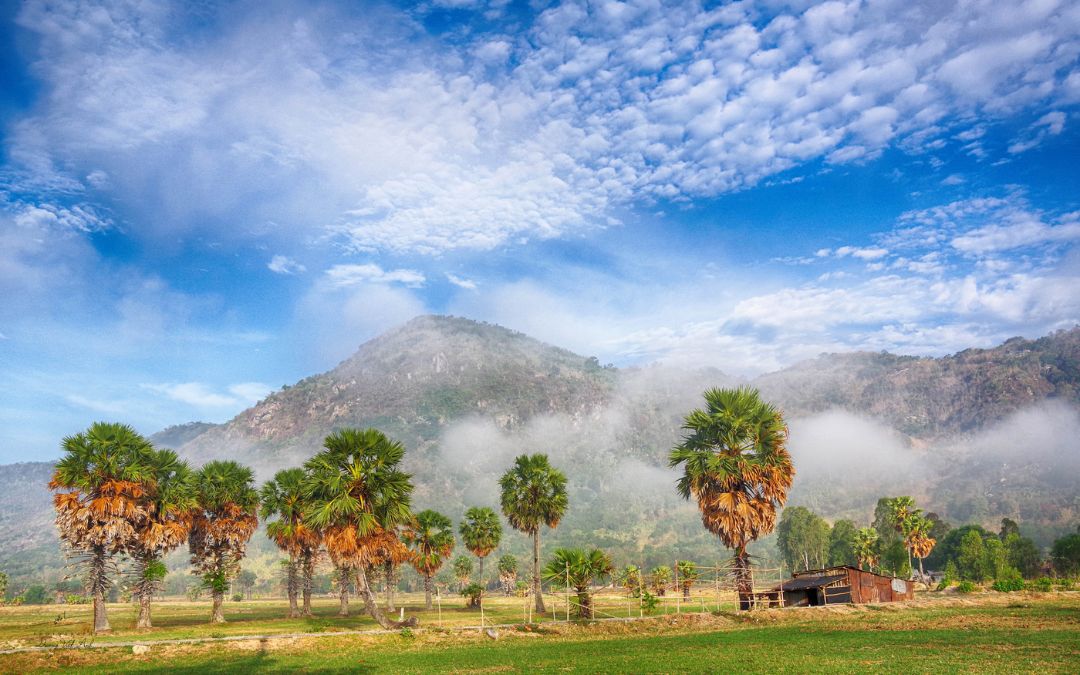
Pilgrims ascend Cam Mountain for sacred peaks and misty delta views.
Yen Tu Mountain (Quang Ninh)
- Best for: Spiritual travelers, cultural hikers.
For centuries, Yen Tu Mountain has been considered the cradle of Vietnamese Zen Buddhism. Located in Quang Ninh Province, this sacred mountain reaches 1,068 meters and is home to a historic pilgrimage trail stretching over 6 kilometers, lined with ancient stone steps, meditation huts, and moss-covered stupas.
King Tran Nhan Tong, who abdicated his throne in the 13th century to found the Truc Lam Zen sect, once lived and meditated here—his legacy lives on in the temple complexes that still dot the mountainside.
The path to the summit passes iconic sites like Hoa Yen Pagoda, An Ky Sinh statue, and the Dong Pagoda, perched near the peak. A modern cable car system now aids those unable to make the full climb, but many still walk in silence, step by step, as part of a mindful pilgrimage.
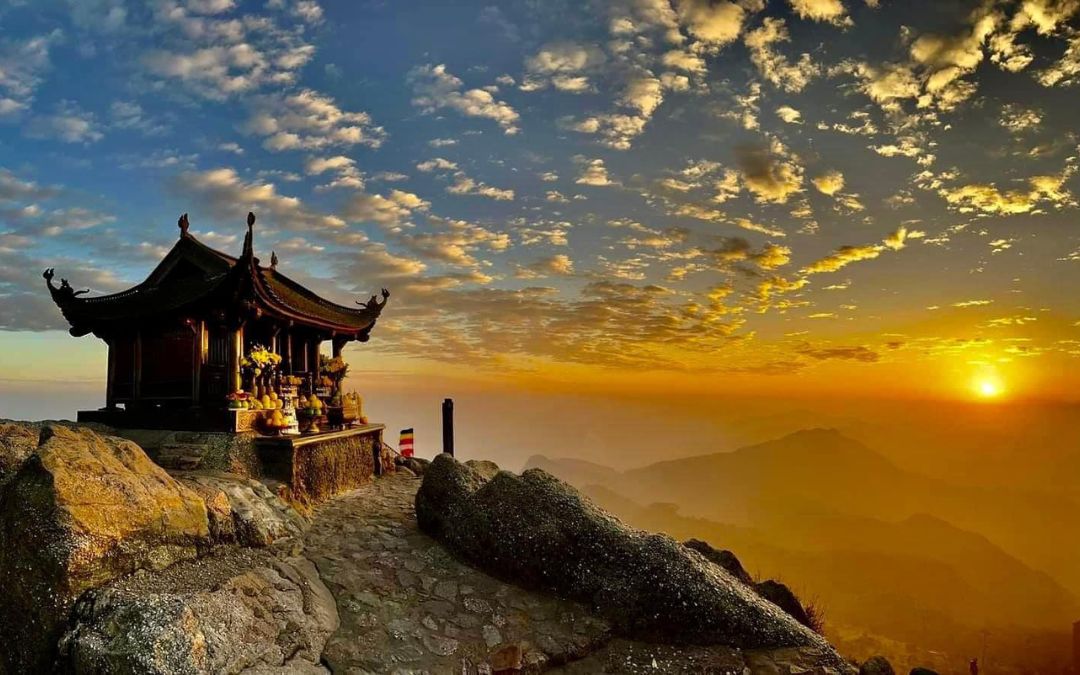
Yen Tu Mountain guides spiritual travelers through clouds and quiet temples.
Planning Tips for the Perfect Mountain Adventure
Whether you’re chasing clouds at high altitudes or strolling through serene ethnic villages, a well-planned trip can make all the difference. Keep these key tips in mind to make your mountain journey in Vietnam safe, enriching, and unforgettable:
Choose the right season for your destination
- Northern Vietnam (e.g., Fansipan, Pu Ta Leng, Ta Xua): Aim for September to April when skies are clear and trails are dry—ideal for trekking and photography.
- Central Highlands (e.g., Ngoc Linh, Chu Yang Sin): April to May brings pleasant temperatures and blooming forest flowers.
- Southern & coastal ranges (e.g., Ba Den, Ta Cu, Cam Mountain): December to April is best for dry weather and cultural festivals.
- Cloud hunting hotspots like Ta Xua or Lao Than are most rewarding between September and March, when fog and sunrise views align perfectly.
Match the trail to your skill level
- Beginners can enjoy lighter climbs like Lang Biang, Marble Mountains, or Sam Mountain, often with cable car options or well-paved paths.
- Intermediate trekkers might try Lao Than, Lung Cung, or Ba Vi, where trails are manageable but scenic.
- Experienced hikers should take on Phu Si Lung, Tay Con Linh, or Ky Quan San, where rugged terrain and multi-day treks test endurance and skill.
Know when permits and guides are needed
- Some peaks, such as Fansipan or Phu Si Lung, require official permits due to conservation zones or military boundaries.
- Remote regions like Tay Con Linh or Ha Giang may also call for permits, especially when entering minority areas or border zones.
- Hiring local guides or porters not only boosts safety but also enriches your experience with local insights and cultural connections.
Pack smart and stay safe
- Dress in layered, weather-adaptable clothing, and bring waterproof gear for unexpected rain.
- Don’t underestimate the terrain—sturdy hiking boots are essential.
- Include a first-aid kit, flashlight, energy snacks, water purification tablets, and maps or GPS tools if trekking without a guide.
- For overnight treks: bring sleeping bags, tents, and adequate food supplies.
Respect nature and local traditions
- Stick to marked trails to preserve fragile ecosystems.
- Avoid picking wild plants or disturbing animals, even for photos.
- In ethnic villages, be mindful when taking pictures. Ask permission, dress modestly, and greet locals with respect.
- Try regional dishes like thịt trâu gác bếp (smoked buffalo), cơm lam, or rượu cần, but leave no trash behind. Pack out everything you bring.
Make room for cultural moments
- Time your visit to coincide with Mu Cang Chai’s harvest season (September–October) to witness golden rice terraces and join local celebrations of the H’mong people.
- Explore Sunday markets in Bac Ha (Lao Cai) or Dong Van (Ha Giang) for vibrant scenes of ethnic minority life, with traditional dress, handicrafts, and regional foods.
- In Mai Chau or Sapa, book a homestay with Thai, H’mong, or Red Dao families to experience local customs, participate in rice farming, or enjoy traditional music and dance around the fire.
- Attend festivals at Ba Den Mountain (Tay Ninh) or Yen Tu Mountain (Quang Ninh) to observe spiritual rituals and mingle with local pilgrims in a deeply sacred atmosphere.
Itineraries for Every Nature Lover
Best Ha Giang Loop Tour
- Duration: 7 days / 6 nights
- Route: Hanoi – Ha Giang – Meo Vac – Dong Van – Quan Ba – Hanoi
This 7-day itinerary invites you to explore Vietnam’s remote northern frontier, where limestone peaks, cloud-covered passes, and ethnic villages unfold in every direction. You’ll cross the legendary Ma Pi Leng Pass, meet H’mong and Dao communities in rustic stilt houses, and immerse yourself in the vibrant energy of highland markets.
Each day blends natural drama with cultural authenticity, ideal for travelers seeking raw landscapes and meaningful encounters far from the tourist trail.
- Itinerary Summary
Day 1: Hanoi Arrival
Touch down in Vietnam’s capital and take your first steps into the land of contrasts—ancient streets, motorbike rhythms, and French colonial charm.
Day 2: Hanoi – Ha Giang – Thon Tha Village
Leave behind the city’s bustle and head north toward Ha Giang, where mountains begin to dominate the skyline.
Discover the tranquil charm of Thon Tha Village, nestled among rice fields and home to Tay ethnic families in palm-thatched stilt houses.
Day 3: Ha Giang – Yen Minh – Meo Vac
Wind through the forested hills of Yen Minh, passing photogenic mountain roads and hidden villages.
Arrive in Meo Vac, where ethnic minorities maintain deeply rooted traditions and the surrounding peaks rise like stone fortresses.
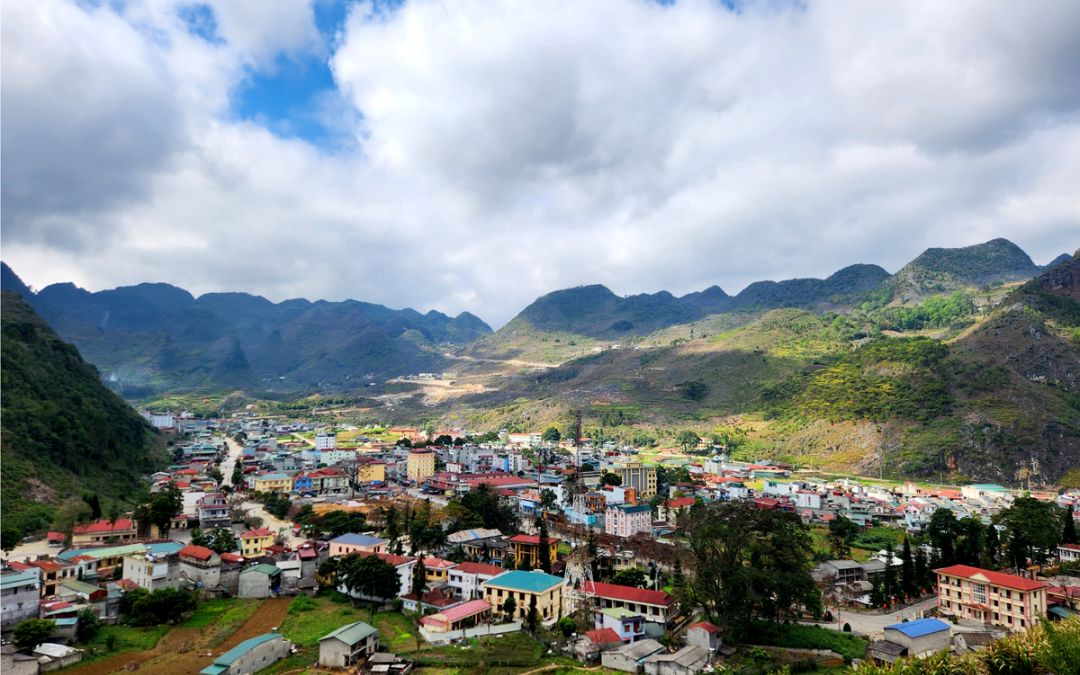
Rich traditions beneath stone-shaped peaks endure in Meo Vac town.
Day 4: Meo Vac – Ma Pi Leng – Dong Van
Drive the jaw-dropping Ma Pi Leng Pass, carved into cliffs above the jade-green Nho Que River.
In Dong Van, explore local hamlets and admire the rocky karst landscapes that give this area its UNESCO Geopark status.
Day 5: Dong Van – Quan Ba
If it’s Sunday, dive into the colorful chaos of Dong Van Market.
Visit Pao’s House (famous from Vietnamese cinema) and the historic H’mong King’s Palace before reaching Quan Ba.
Day 6: Quan Ba – Hanoi
Stroll through a nearby Dao village and browse local handicrafts at a rural market.
Then journey southward, retracing winding roads back to Hanoi.
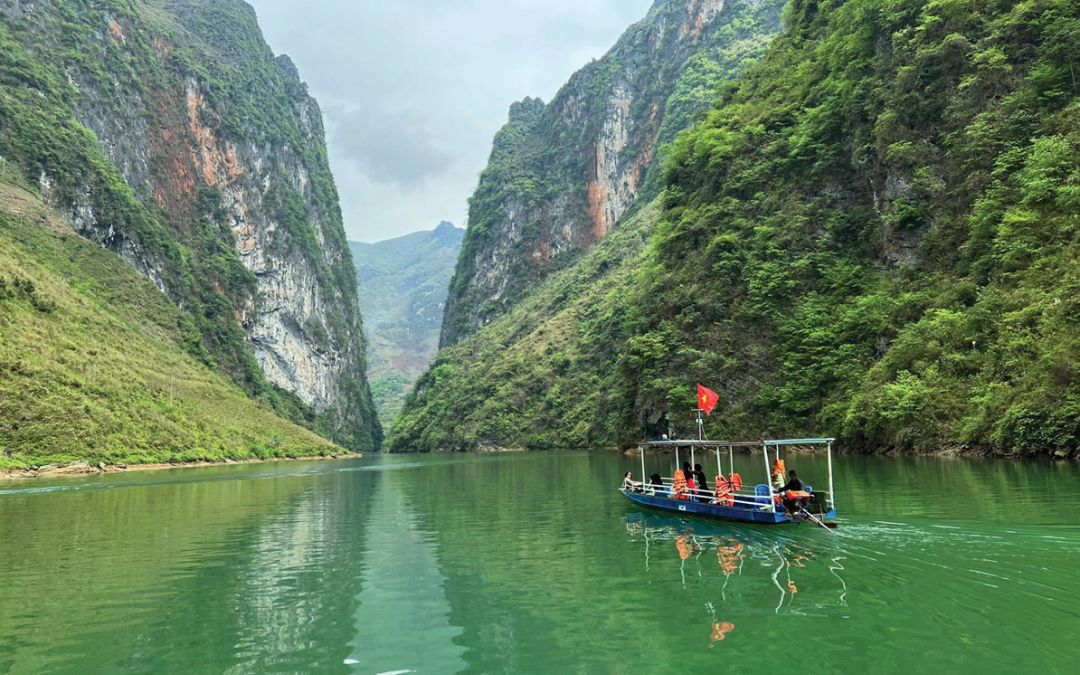
Those who love drifting by boat should journey to the serene Nho Que River.
Day 7: Hanoi Departure
Spend your final morning reflecting on misty mountains, warm smiles, and winding roads before heading to the airport for departure.
>> Get More Details Here: Best Ha Giang Loop Tour
Vietnam: The Northwest Loop
- Duration: 12 days / 11 nights
- Route: Hanoi – Mai Chau – Son La – Dien Bien – Lai Chau – Sapa – Bac Ha – Mu Cang Chai – Nghia Lo – Hanoi
This 12-day expedition leads you into the captivating highlands of Northwest Vietnam, where dramatic mountain passes, lush rice terraces, and ethnic minority cultures come alive. From the peaceful stilt houses in Mai Chau to the historic battlegrounds of Dien Bien Phu, every stop blends striking scenery with cultural immersion.
You’ll explore Sapa’s tribal villages, shop at the vibrant Bac Ha Sunday Market, and hike through the world-famous rice terraces of Mu Cang Chai. Ideal for culture seekers, nature lovers, and off-the-beaten-path adventurers.
- Itinerary Overview
Days 1–3: Hanoi – Mai Chau – Son La
Start in Hanoi, then head to Mai Chau Valley to explore Thai villages, caves, and enjoy traditional music and food.
Continue to Son La, visiting the French-era prison, passing Moc Chau’s tea hills and highland scenery.
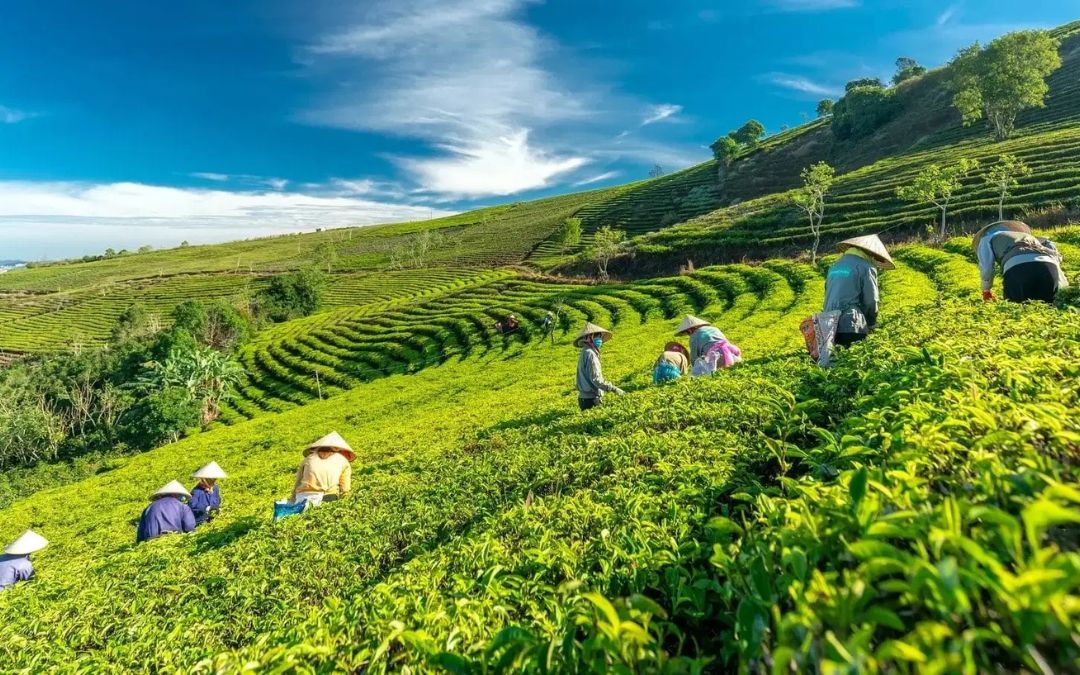
Moc Chau’s tea hills stretch in waves as farmers harvest under clear skies.
Days 4–6: Dien Bien – Lai Chau – Sapa
Explore Dien Bien Phu’s war memorials and former battlefield sites.
Travel through remote mountains to Lai Chau, then ascend to Sapa via Tram Ton Pass, stopping at waterfalls and hiking forest trails.
Days 7–9: Bac Ha – Ta Phin – Mu Cang Chai
Join locals at the colorful Bac Ha Sunday Market, then trek through Ma Tra and Ta Phin villages to meet Red Dzao families.
Continue to Mu Cang Chai for rice terraces and time with the Black Thai community.
Days 10–12: Nghia Lo – Suoi Giang – Hanoi
Trek the heritage terraces of La Pan Tan before relaxing in Nghia Lo.
Visit Suoi Giang’s ancient tea forests, then return to Hanoi for your departure.
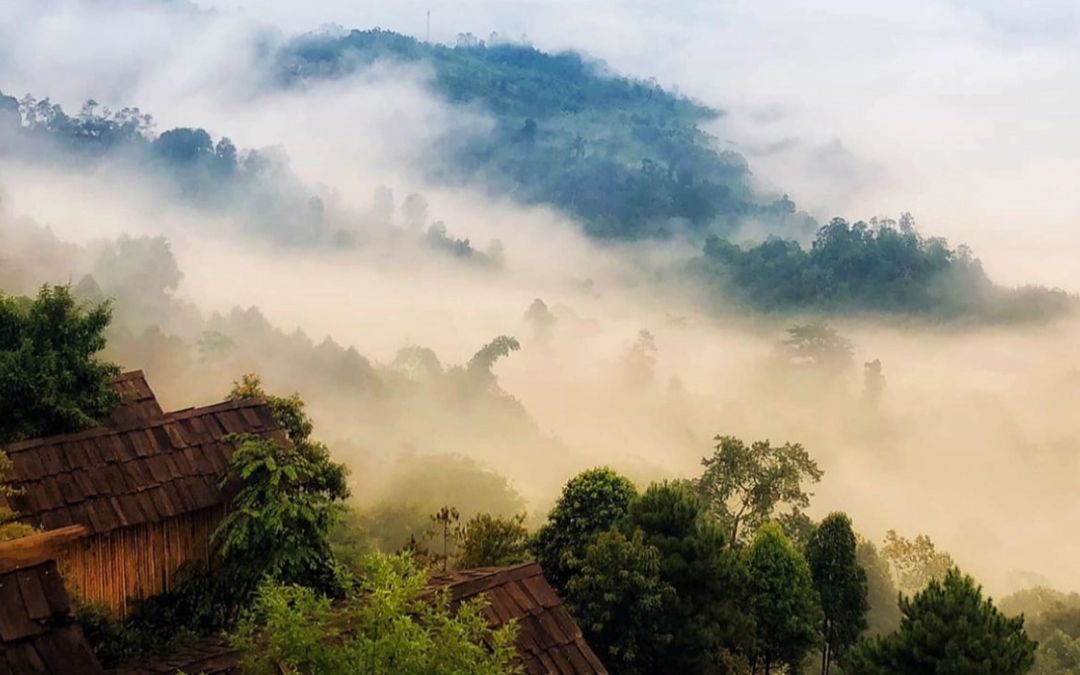
Misty heritage and ancient tea trees await visitors in Suoi Giang forests.
>> See Tour: Northwest Vietnam Tour 12 Days
Vietnam Off the Beaten Path
- Duration: 12 days / 11 nights
- Route: Hanoi – Mai Chau – Son La – Dien Bien – Lai Chau – Sapa – Bac Ha – Mu Cang Chai – Nghia Lo – Hanoi
This 12-day journey through Northwest Vietnam takes you deep into the heart of ethnic culture, mountain landscapes, and historical landmarks. You’ll walk among rice terraces in Mu Cang Chai, explore hill tribe villages in Sapa, shop at the vivid Bac Ha Market, and visit key sites from the battle of Dien Bien Phu.
Along the way, connect with local families, enjoy traditional cuisine, and witness the contrasting beauty of Vietnam’s rugged highlands and peaceful valleys. Ideal for active travelers seeking both adventure and cultural immersion.
- Itinerary Overview
Days 1–3: Hanoi – Mai Chau – Son La
Start in the capital, then drive through scenic countryside to Mai Chau, where you’ll explore peaceful stilt-house villages like Pom Coong and Lac.
Continue through the Moc Chau Plateau to reach Son La, visiting Pa Co Market and learning about local ethnic diversity.
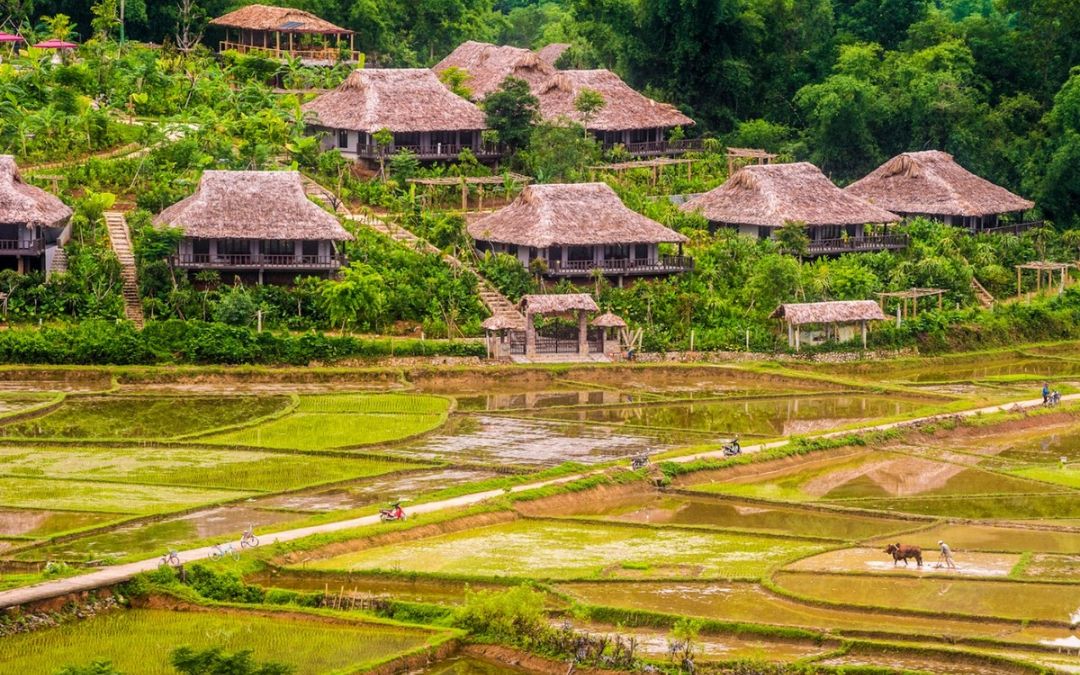
Pom Coong welcomes visitors with stilt houses and calm rice field rhythms.
Days 4–6: Dien Bien Phu – Lai Chau – Sapa
Step into history at Son La Prison, then cross mountain passes like Pha Din en route to Dien Bien Phu.
Tour key wartime sites, including A1 Hill, the War Museum, and the former French bunker.
Pass through remote areas of Phong Tho to reach Lai Chau, and journey over Tram Ton Pass into Sapa, stopping at Silver Waterfall and Love Waterfall along the way.
Days 7–9: Bac Ha – Ta Phin – Mu Cang Chai
Spend a day at the colorful Bac Ha Sunday Market, where ethnic groups gather to trade handmade goods, livestock, and textiles.
Visit Trung Do Village and enjoy a riverboat ride through remote countryside. Trek through Suoi Ho, Ma Tra, and Ta Phin, meeting Red Dzao families and learning about their healing herbal traditions.
Travel on to Mu Cang Chai, famous for its UNESCO-designated rice terraces and vibrant H’mong culture.
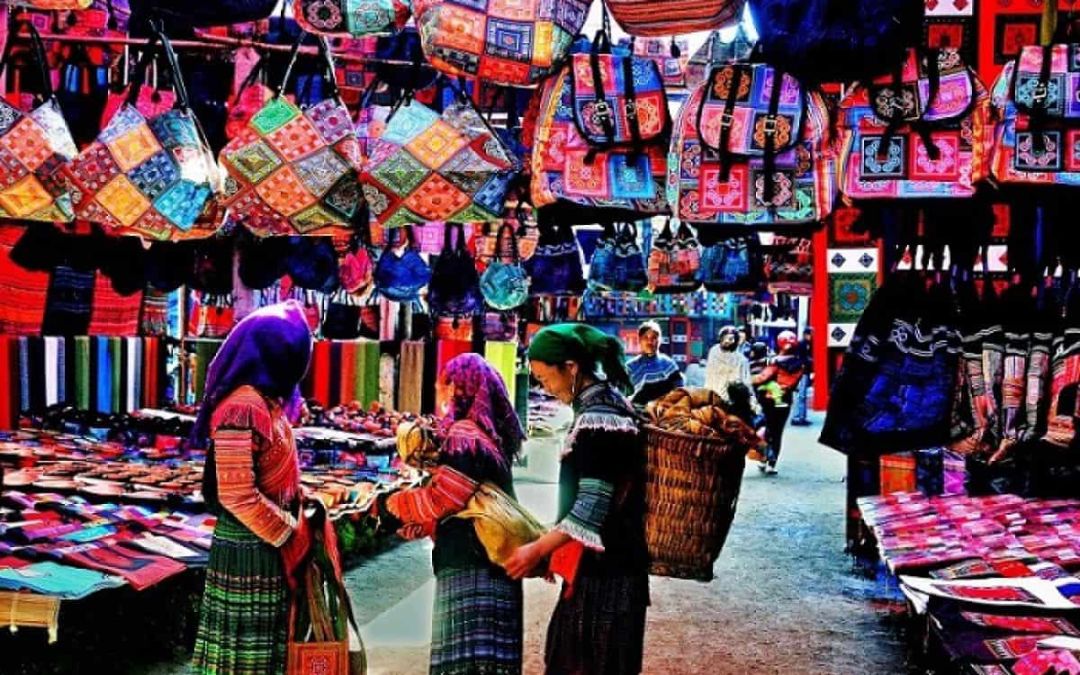
Visitors are drawn to Bac Ha’s vibrant colors and rich cultural spirit.
Days 10–12: Nghia Lo – Suoi Giang – Hanoi
Hike among the dramatic terraced fields of La Pan Tan and Che Cu Nha, then unwind in the peaceful valley of Nghia Lo.
Visit Suoi Giang Eco Park, home to ancient tea trees and traditional green tea processing.
The final stretch brings you back to Hanoi, closing the loop with one last glimpse of Vietnam’s diverse and captivating north.
>> See Tour: Vietnam Off the Beaten Path 22 Days
Vietnam’s mountains are more than just peaks — they’re stories carved into the earth, waiting to be explored. Each trail leads to a new perspective, a cultural encounter, or a moment of silence above the clouds. Whether you’re chasing panoramic views or off-the-grid adventure, these 17 mountains promise unforgettable journeys across the country’s most breathtaking terrain.
Ready to hike beyond the ordinary? Let Asia Pioneer Travel take you there with thoughtfully designed journeys, local insights, and authentic experiences that bring every mountain to life.
